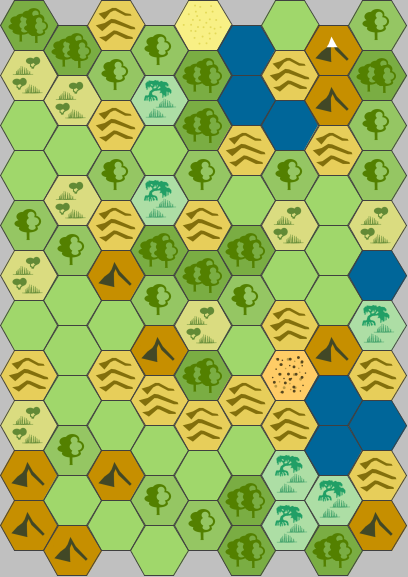 |
| The Test Map |
There are eight tables, each based around a central terrain type: plain, woodland, mountain, desert, wetland, coastline, and ocean, plus a random table that effectively forces a change in terrain. Each table favors it's primary terrain type plus variants, but also includes similar types that might appear nearby. Each table entry also includes a table number, with same-type terrain referring back to the same table. If you're using table II, plains and roll plains, the new table number is also II. But, if you generate mountains, the table number is IV. When generating hexes you record both terrain and table number, then use the table numbers of neighboring hexes to select the table to use when generating new hexes.
 |
| Plains Table (II) |
To generate hexes, use the following rules to select a table, using the first rule that matches:
- If next to ocean, use table VIII (ocean table).
- Use the lowest numbered table from any generated neighboring hexes.
- If there are no neighbors, use table I (random table).
Record both the terrain, and the listed table number, then move on to the next hex. If a result indicates coastline, mark the hex, then place two ocean hexes (if possible) in adjacent hexes. Once terrain around the coastline hex has been fully generated, choose the most common type as the coastline hex's terrain.
As you can see from the map, the results are decent. The biggest oddity in the sample is the desert hex next to forest on the north edge, and the generally unsatisfactory ocean layout. There's also a tendency for plains terrain to take over the world, since it's the lowest-numbered, terrain-based table. The random table, table I, was my attempt to fix that. I'm not 100% sure it's doing what I want. I may alter rule two to read:
- Use the most common table number from any generated neighboring hexes. Resolve ties by using the lower table number.
- It's probably worth leaving a link to the final result here...
Mark,
ReplyDeleteIs that the completer chart?
-K
Right now it is. I'm using Excel to do the prototype work. Eventually I'll get it out in some usable form.
ReplyDeleteLooking forward to it. :D
ReplyDelete